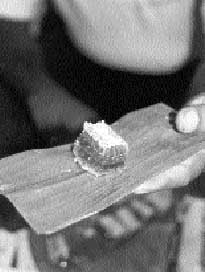Mention bees, and most people think of honey. Almost every society on earth has traditionally known and used honey. Cave paintings near Valencia in Spain from 15 000 years ago depict men gathering honey. The Bible and the Koran extol the virtue of honey as a valuable and nourishing food. The reputation of honey as a wholesome and popular commodity is a useful basis upon which to create livelihoods.
Flowers need bees to visit them so that plants will be pollinated. As an incentive, they supply nectar. Nectar is a solution of sugars and other minor constituents that bees collect and concentrate into honey. Honeys contain a wide range of sugars, varying according to the nectar source, and small amounts of other substances such as minerals, vitamins, proteins and amino acids. The temperature in a nest near the honey storage area is usually about 35 °C. This temperature and the ventilation produced by fanning bees cause water to evaporate from the honey. When the water content is reduced to about 20 percent, the bees seal the cell with a wax capping. The honey is now considered "ripe" and will not ferment. In this way the bees prepare for themselves a concentrated food source packed in minimal space. It is free from problems of fermentation; therefore bacteria cannot grow in the honey and it will not deteriorate during storage. This food sustains the bees through periods when there are no flowers.
Pollen is a minor but important component of honey. It is carried to the nest and stored quite separately from nectar, but a few pollen grains inevitably find their way into nectar and eventually into the honey. If the pollen in honey is identified through a microscope, it gives a guide to the plants on which the bees have been foraging.
The aroma, taste and colour of honey are determined by the plants from which the bees have gathered nectar. Sunflowers, for example, give a golden yellow honey; clover gives a sweet, white honey; a gave species give honey a bitter taste that is popular in some societies. Dark honey usually has a strong flavour and often has a high mineral content; pale honey has a more delicate flavour. The popularity of dark and light honey varies from country to country. Colour can also indicate quality, because honey becomes darker during storage or if it is heated. However, some perfectly fresh and unheated kinds of honey can be dark in colour.
Glucose is a major constituent of honey. When the glucose crystallizes, the honey becomes solid and is known as granulated honey. Depending on the plants the bees are visiting, some kinds of honey are more prone to granulation than others; almost all honey granulates if its temperature falls below 15-24 °C. As with colour, different people favour different qualities of honey. Some prefer granulated honey, while others choose liquid honey. Granulation is a natural process; there is no difference in nutritional value between solid and liquid honey. Some kinds of honey look cloudy because they contain a high level of pollen. Such honey is sometimes said to be of low quality, although the presence of pollen makes the honey even more nutritious. In Europe and North America, a new market is developing for honey that has been cold-filtered and not processed to remove all pollen.
Honey inside the nest that the bees have sealed with a wax capping is regarded by beekeepers as ready for harvest. Honey at this stage is pure and perfect, whether it is in a wild nest, a home-made hive or the most expensive factory-made hive. The subsequent harvesting and processing of honey determine whether this quality is retained or whether it will be spoiled by contamination, overheating or over-filtration. This means that rural beekeepers using simple equipment can produce honey of top quality. If the beekeepers are working in remote places far from roads and industry, the honey may even be certified as organic and command a premium price. Honey processing on a small-scale requires the same simple equipment that is used in other forms of food preparation: bowls, sieves or straining cloths and containers.

FIGURE 9 Piece of honeycomb in India. When honey is presented this way, the consumer can see that it is fresh and uncontaminated.
If the water content of honey is greater than 23 percent, the honey is likely to ferment. Low water content is therefore important. Water content can be measured using a honey refractometer, which is a small instrument that measures the refraction of light as it passes through a glass prism on which a few drops of honey have been smeared. In climates with high humidity where it can be difficult to retain low water content in honey, airtight plastic buckets with lids are essential for honey storage.